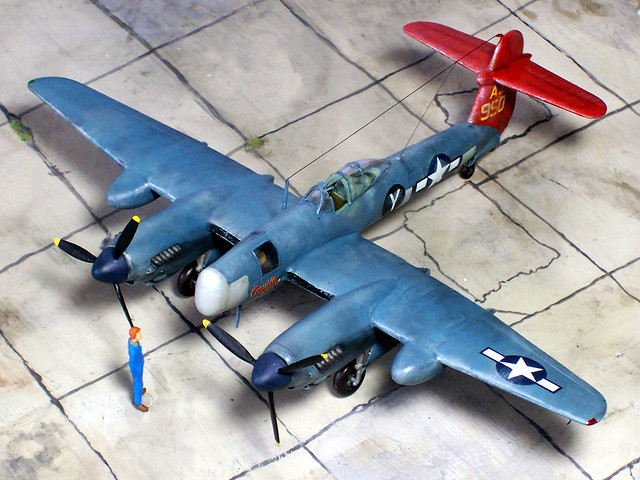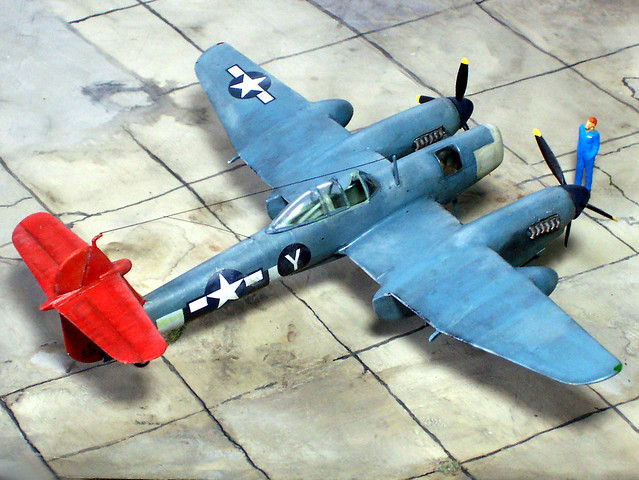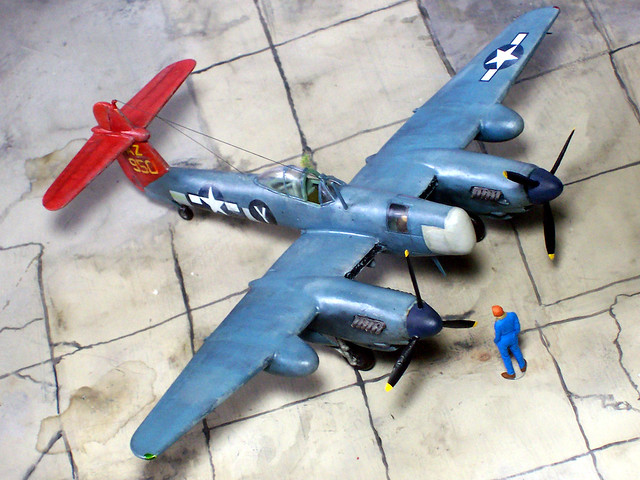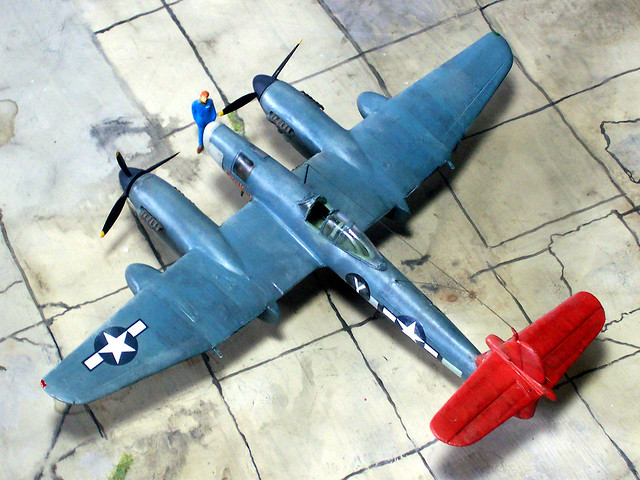Noch eine umgebaute Whirlwind - diesmal inspiriert von einer ganzen Sammlung fiktionaler Profile eines Modellbau-Kollegen aus Kanada:
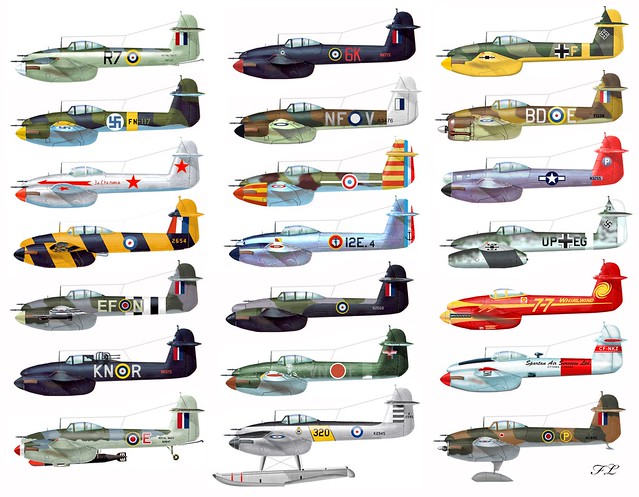
Westland Whirlwind "What if" 3 by
François, on Flickr
Bunte Auswahl, und ich fand den Pfadfinder sehr ansprechend, sowohl was Lackierung (komplett PRU Blau mit rotem Heck) als auch Konzept betrifft. Daraus ist im heimischen OP dann der "Pelikan" geworden, bzw. mit vollem Titel: Westland Whirlwind PR.III, aircraft MB 950/'(AZ-)Y' of 653rd Bomb Squadron (Light), USAAF 25th BG, 8th AF; Woodhall Spa, Lincolnshire, early 1945.

 Some background:The Westland Whirlwind (Whirly or Whirlibomber in RAF slang) was a British twin-engined heavy fighter developed by Westland Aircraft. It was the Royal Air Force's first single-seat, twin-engined, cannon-armed fighter, and a contemporary of the Supermarine Spitfire and Hawker Hurricane. It was one of the fastest aircraft in service when it flew in the late 1930s, and was much more heavily armed than any other.
Some background:The Westland Whirlwind (Whirly or Whirlibomber in RAF slang) was a British twin-engined heavy fighter developed by Westland Aircraft. It was the Royal Air Force's first single-seat, twin-engined, cannon-armed fighter, and a contemporary of the Supermarine Spitfire and Hawker Hurricane. It was one of the fastest aircraft in service when it flew in the late 1930s, and was much more heavily armed than any other.
However, protracted development problems with its Rolls-Royce Peregrine engines delayed the entire project and only a relatively small number were ever built. During the Second World War only two RAF squadrons were equipped with the Whirlwind, and despite successful use as a fighter-bomber it was withdrawn from service in 1943.



After retirement in December 1943, the surviving Whirlwinds were sent to 18 Maintenance Unit at Dumfries, Scotland, where they were to be scrapped - but this was halted in early 1944 when the remaining airframes were modified for a completely new role: as radar-equipped pathfinders with the new, American H2X radar.
The H2X radar ("Mickey set", AN/APS-15) was an American development of the British H2S radar, the first ground mapping radar to be used in combat. It was used by the USAAF during World War II as a navigation system for daylight overcast and nighttime operations. It used a shorter 3 cm wavelength (10 GHz frequency) than the H2S, giving a sharper picture (H2S subsequently adopted 3 cm in the Mark III version entering operational service on November 18, 1943, for “Battle of Berlin”) and not known to have ever been spotted by the German Naxos radar detector, due to that receiving device's specific purpose being to spot the original British H2S equipment's lower frequency, 3 GHz emissions.



The hemispherical radome for the H2X's rotating dish antenna replaced the much bigger ball turret of the H2S, which was e. g. installed under Avro Lancaster bombers. The first H2X-equipped aircraft, B-17s, arrived in England in early February 1944, and were first used in combat later that month, and the first use of the "Mickey" was against Ploesti on April 5, 1944.
Availability of the new radar systems was scarse, so the idea of special aircraft guiding groups of bombers was born. Furthermore, due to the absence of radar maps as guidance, respective reconnaissance and radar mapping missions had to be conducted.
Consequently six PR Mk.XVI de Havilland Mosquito aircraft in the 482nd Bomb Group were equipped with H2X equipment in April 1944. The idea was to produce photographs of the radar screen during flights over Germany allowing easy interpretation of these radar images in later bombing runs. Three aircraft were subsequently lost in training, and the project was discontinued, but the idea was kept up.



Twenty Westland Whirlwind airframes as well as further twelve PR Mk.XVI de Havilland Mosquito aircraft were fitted with H2X. The Whirlwinds saw major modification: first of all, the complete nose section was redesigned. The cannon armament was replaced by a more spacious, deeper compartment that carried the H2X in the nose section behind an opaque perspex cover, as well as the technical equipment for the radar and a work station for a radar operator right in front of the cockpit.
The Whirlwind's original Peregrine engines were replaced by bigger, more powerful Merlin 76, which were optimized for high altitude operation. The engines also featured cabin pressure blowers that supported a pressurized crew compartment . Wet hardpoints under the wings were added, so that drop tanks extended the range. Theoretically, two 1.000 lb (454 kg) bombs could be carried, but the Whirlwind PR.3, how the aircraft was officially designated, normally flew unarmed.



The new machines were allocated to RAF No. 627 Squadron. This squadron had been formed on 12 November 1943 at RAF Oakington from part of 139 Squadron, and it was originally equipped with the de Havilland Mosquito. It flew operations as part of No. 8 Group's light bomber force. Beyond normal bombing missions it also carried out Pathfinder duties and was involved in attacks on Berlin in early 1944. In April 1944 it was transferred to No. 5 Group as a specialised target marking squadron, although it also carried out amend reconnaissance and normal bombing duties.
Beginning in May 1944 the Whirlwinds were, together with some radar-equipped Mosquitos, integrated into American Bomber Groups and joined by American aircraft, e .g. modified P-38Ls. Nicknamed "Pelican" by the crews, the retrofitted Whirlwinds flew bomber guidance and radar mapping night missions until February 1945. The sets tended to overload the aircraft's electrical system and occasionally exploded, and Mickey aircraft had the highest loss, abort and mission failure rates, so that service was severely curtailed after February 19, 1945, but the machines were kept in service and flew photo and weather reconnaissance missions until the end of the hostilities.


General characteristics:Crew: One pilot
Length: 35 ft 4 1/2 in (10.80 m)
Wingspan: 45 ft 0 in (13.72 m)
Height: 11 ft 0 in (3.35 m)
Wing area: 250 ft² (23.2 m²)
Airfoil: NACA 23017-08
Empty weight: 8.800 lb (3.,995 kg)
Loaded weight: 11.467 lb (5.206 kg)
Max. take-off weight: 12.665 lb (5,750 kg)
Powerplant:2× Rolls-Royce Merlin 76 liquid-cooled V-12 and fitted with a two-speed, two-stage supercharger and a Bendix Stromberg anti-g carburettor, rated at 1.233 hp (919 kW) at 35,000 ft (10,668 m) and driving de Havilland constant speed propellers with a diameter of 9 ft 10 in (3.00 m)
Performance:Maximum speed: 415 mph (361 kn, 668 km/h)) at 28,000 ft (8,500 m)
Stall speed: 95 mph (83 knots, 153 km/h) (flaps down)
Range: 900 mi (782 nmi, 1.400 km))
Service ceiling: 37.000 ft (11.000 m)
Armament:Basically none. Two underwing hardpoints, normally occupied with a pair of 62 imp. gal (450l) slipper tanks. Alternatively a pair of bombs of up to 1.000 lb (454 kg) caliber could be carried, or racks with target indicator bombs, inclusing various candles and No. 1 Mk 1 TI Bombs, No. 7 Mk 1 Multi-flash Bombs or No. 8 Mk 1 Spotfire Bomb
Im Prinzip ist das eine alte Airfix-Whirlwind, auf die die Radar-Nase eines P-38-Pathfinders (Dragon) mit Innenleben gesetzt wurde, plus "Hängebauch" mit Kameras als Übergang. Auch die Treibwerke sind neu: die Merlins sind aus Resin und stammen von Pavla. Insgesamt viel Fummelei, auch beim Anstrich, z. B. mit übermalten/durchschimmernden Invasions-Streifen.

